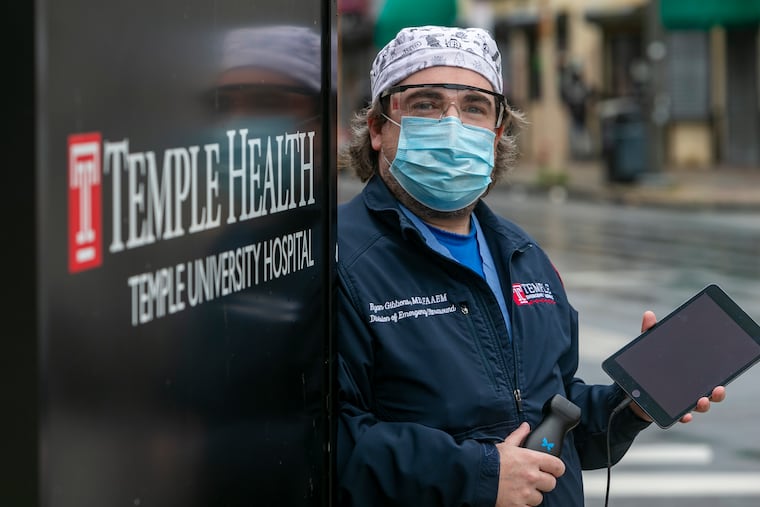To detect pneumonia in COVID-19 patients, these Temple doctors use ultrasound
A study found the devices performed better than X-rays, in some respects.

Like any physician, Ryan Gibbons learned in medical school how to listen to a patient’s lungs with a stethoscope.
But in the emergency department at Temple University Hospital, he never carries one — despite having evaluated the lungs of hundreds of COVID-19 patients since April.
Instead, he opts for ultrasound: the same technology used to look inside the womb of a pregnant woman.
In a new study, he and colleagues at Temple’s Lewis Katz School of Medicine found that a portable ultrasound device was highly effective in identifying which patients suffered from pneumonia, a common complication in those with severe COVID-19.
The concept of using ultrasound to diagnose pneumonia has been around for years but has been slow to catch on in the United States. When physicians suspect pneumonia, they remain more likely to order a chest X-ray (after first using a stethoscope to listen for any telltale crackling that suggests the presence of fluid).
Yet because ultrasound devices are now available in portable versions, they are a natural fit in the coronavirus pandemic, Gibbons said. Consisting simply of a handheld probe attached to an iPad or other tablet, they are easy to sanitize in between patients, limiting the spread of infection. No need to send a patient off to radiology, potentially exposing additional health-care workers.
» READ MORE: This Penn scientist paved the way for the Pfizer COVID-19 vaccine
A physician can still conduct an initial exam with a stethoscope before using ultrasound. But Gibbons does not bother, saying it can be hard to hear in the emergency room, and even harder in the white COVID-19 triage tent outside Temple’s emergency entrance on Germantown Avenue. The tent was erected during the initial wave of cases in the spring, and was recently set up again in anticipation of a fall surge.
“Ultrasound is definitely my go-to,” he said.
Physicians have studied the use of the handheld devices for diagnosing pneumonia in developing countries and other places with limited X-ray equipment. But the Temple study, along with other recent research, suggests that ultrasound is a good option for identifying the lung condition in any hospital, said Laura E. Ellington, a pediatric pulmonologist at Seattle Children’s.
“It’s portable, it’s quick to use, and there’s no radiation exposure,” said Ellington, who was not involved with the Temple study but has studied the use of lung ultrasound in Peru. “It has a lot of potential for use as a screening tool.”
And unlike a static X-ray, ultrasound produces many images per second, allowing the provider to see a real-time “movie” of the lungs in action.
But whitish shadows of fluid and inflammation associated with pneumonia appear different on the screens of the two kinds of devices. As with so much else in medicine, physicians’ preference for one technique over the other may depend on how they were trained, she and Gibbons said.
Ultrasound devices work by transmitting high-frequency sound waves through a probe placed on the patient’s skin. When the waves hit a boundary between two different types of tissue (say, flesh and fluid), some of them are reflected back. The device calculates the location of various tissues or pockets of fluid based on how long it takes for the sound waves to return.
(“Ultra” means too high a frequency for humans to hear. But the sound waves used for medical imaging are way higher than that threshold — well beyond the limits of dogs or even beluga whales, the high-pitch hearing champs of the animal kingdom.)
The Temple study, presented at a recent research forum of the American College of Emergency Physicians, included 110 patients who came to the emergency department with shortness of breath and other possible signs of COVID-19. All underwent a lung ultrasound as well as a chest X-ray, so that researchers could compare the accuracy of the two approaches.
The ultrasound images suggested pneumonia in 99 cases, while the X-rays did so only in 73 cases. All patients then underwent a CAT scan — considered the “gold standard” for confirming pneumonia — and 81 were identified as actually having the condition.
Further analysis revealed that ultrasound had correctly identified almost all of the pneumonia cases, whereas X-rays identified only about two-thirds of them. Yet while correctly capturing most of the true cases, ultrasound also was more likely than X-ray to yield a “false positive” — a finding of pneumonia in patients who did not actually have it.
That is OK, said Gibbons, who uses a handheld ultrasound device called the Butterfly iQ. He would prefer to cast a wide net rather than risk missing some real cases that need treatment.
Generally, COVID-19 patients whose ultrasound scans suggest that they are free of pneumonia can be sent home to quarantine, provided they are otherwise healthy and do not need oxygen.
But those with signs of pneumonia, whether seen on an ultrasound or X-ray, are given a CAT scan to confirm the diagnosis, Gibbons said. CAT scans are not used as an initial step because they expose patients to higher levels of radiation, and also they take longer.
Gibbons said that, for now, ultrasound devices are catching on fastest in emergency rooms, where speed is a benefit. He is not sure how much it will catch on in other non-emergency settings, when physicians have more time to wait for laboratory findings, X-rays, and other clues to guide a diagnosis.
But for quickly determining who may be at risk of severe COVID-19, he keeps an ultrasound device close at hand.